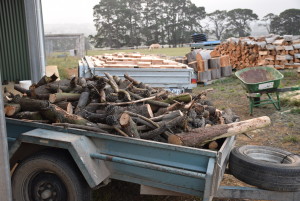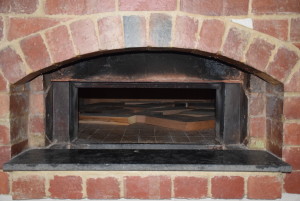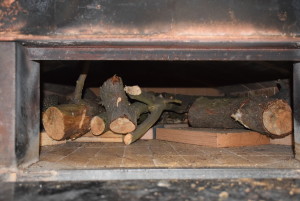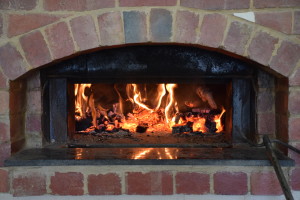I thought I’d do a bit of a blog about lighting the oven. The oven is an Alan Scott designed oven, with a low roof and thick thermal mass all around the 6 x 4 foot oven. It is an absolute beauty, and although its not the quickest to respond to demands of hotter or cooler, it can retain so much heat for so long it hasn’t ceased to amaze me yet! I love opening the door of the oven one, two, three days after its been fired and feeling the heat coming from it and wanting to utilise it however we can. Often that means carrying a roast or custard or big batch of biscuits up from the house to put in, but it is worth the little walk!
So this process starts for us the night before a bake day…..or really, when the wood is collected, which is either from a mill, or from under some of our many pines on the farm.
This is then stacked at the back of the bakery, generally with a bit of banter as to whether certain people ( ie: Greg and I ) are stackers or chuckers of fire wood in general…… The kids are good helpers too.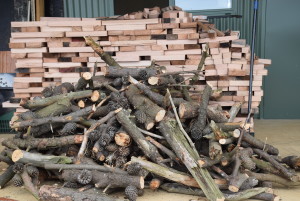
The night before a bake the oven is loaded, with a layer of mill ends going in first; these are nice and flat and slide in pretty easily.
Bigger pieces in towards the back, and smaller branches at the front with pines cones on them are ideal for getting the fire going. It is always still well over 100 degrees clecius when it’s lighted, so the fire generally gets going pretty quickly. I put in a bit of paper and some kindling or sticks and some pine cones…..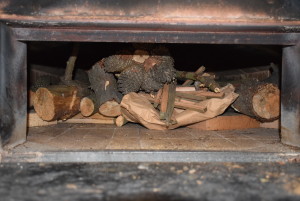
One match is all it needs now….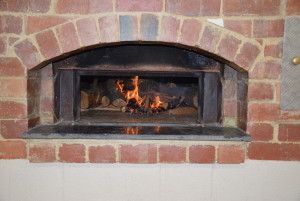
It’s not long till a beautiful fire is going,
and perhaps an hour after it’s been lighted, it’s ready to shut down for the night with this door below, however, overnight it is left ajar so that a small draft can get in, and the smoke can go up the chimney which is located directly on this side of the oven entrance. You can see the black on the bricks from the smoke in the photo above. Then it just quietly does its thing, burning slowly from the front to the back. The heat generated is absorbed into the thermal mass all night, and this continues well into the next afternoon. Early in the morning when I come up to the bakery, I check the fire first; it is generally still glowing fiercely away in the back of the oven, and at some point when it is almost burnt out, I will pull the coals forward and shut it down completely to balance out the heat. The photo below shows the door closed completely. The little door to the right of the oven door houses a thermometer which shows the temperature inside the oven at a certain point, and near the outside of the thermal mass, at a certain point. When the oven is ready to bake ( and hopefully the bread is ready about then too!) the oven and thermal mass will have balanced out at about 300 degrees celcius, about mid-afternoon.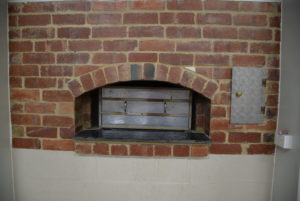
Then the oven needs to be cleaned, first with a special scraping tool that Greg made, which pulls all the ash forward and out of the oven. The ash falls down the ash slot which is between the marble front piece and the floor of the oven. So no sweeping up ash and carrying it out; it just falls in to the cavity below the oven, where it can be cleaned out maybe once a year. There are a few coals left in this photo, usually it is just ash that is left, but if the bread cant wait, if it is proved and ready to bake, sometimes the oven may have to be cleaned out a bit sooner.
Next a couple of goes with the mop, to get all the ash out.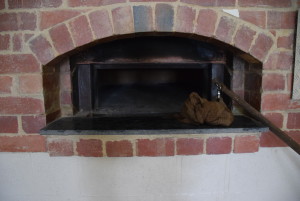
Then on goes the stainless steel door, which pivots and swings down flat when pushed with a loaded peel. This door swings back up immediately the pressure is taken off it, so retaining heat and steam in the oven.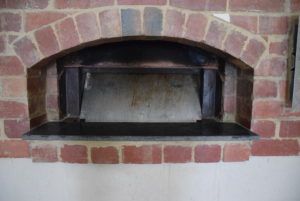
And we’re ready to load! Peel, the handle resting on step ladder for that purpose, semolina in the container to the left, and razor for slashing. Semolina first, then the loaves get turned out of the bannetons onto the peel, and in they go. These are sticky little beetroot loaves. I am getting better all the time at loading, and on big bake days, Greg and I tag team it and load really quickly, which is important, as the first loaves in are the last loaves out! 
So it’s quite a process really! Hard work, but good fun 🙂

